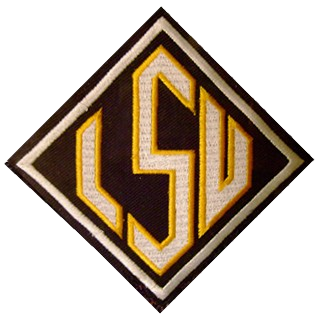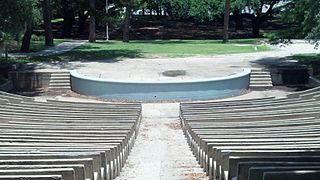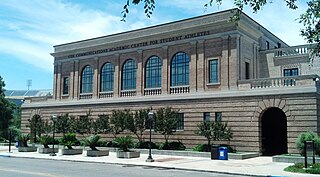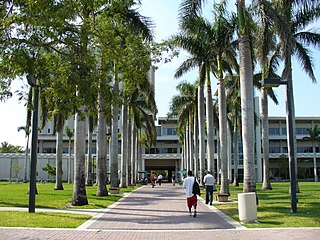Related Research Articles

Louisiana State University is an American public land-grant research university in Baton Rouge, Louisiana, United States. The university was founded in 1860 near Pineville, Louisiana, under the name Louisiana State Seminary of Learning & Military Academy. The current LSU main campus was dedicated in 1926 and consists of more than 250 buildings constructed in the style of Italian Renaissance architect Andrea Palladio, occupying a 650-acre (260 ha) plateau on the banks of the Mississippi River.

Grambling State University is a public historically black university in Grambling, Louisiana. Grambling State is home of the Eddie G. Robinson Museum and is listed on the Louisiana African American Heritage Trail. Grambling State is a member-school of the University of Louisiana System and Thurgood Marshall College Fund.

Tiger Stadium, popularly known as "Death Valley", is an outdoor stadium located in Baton Rouge, Louisiana, on the campus of Louisiana State University. It is the home stadium of the LSU Tigers football team. Prior to 1924, LSU played its home games at State Field, which was located on the old LSU campus in Downtown Baton Rouge.
The University of Alabama is a school with many traditions. This article describes several of these traditions.

The LSU Tigers and Lady Tigers are the athletic teams representing Louisiana State University (LSU), a state university located in Baton Rouge, Louisiana. LSU competes in Division I of the National Collegiate Athletic Association (NCAA) as a member of the Southeastern Conference (SEC).

"Carmen Ohio" is the oldest school song still used by Ohio State University. The song was composed by freshman athlete and Men's Glee Club member Fred Cornell in 1902 or 1903. According to some accounts, he composed it on the train ride home from Ann Arbor, Michigan after Ohio State suffered an 86-0 loss to the Michigan Wolverines. The song is set to the tune of "Spanish Hymn", or "Spanish Chant". The Men's Glee Club first performed it in 1903; however, it did not gain popularity until after its publication in The Lantern on October 10, 1906. At the following Ohio State–Michigan football game on October 20, 1906, "Carmen Ohio" was published in the program. In 1915, Cornell recalled that he wrote the song in 1903 at the request of the Men's Glee Club, and other family members later stated that the train story might be an exaggeration or outright fabrication. Currently, after every home football game in Ohio Stadium, win or lose, the football team and the crowd sing the first verse of Carmen Ohio, accompanied by The Ohio State University Marching Band. It is also sung by new graduates at the end of the university's commencement ceremonies, after diplomas are distributed.

The LSU Tigers football program, also known as the Fighting Tigers, represents Louisiana State University in college football. The Tigers compete in the Football Bowl Subdivision (FBS) of the National Collegiate Athletic Association (NCAA) and the Western Division of the Southeastern Conference (SEC).

The LSU Tigers men's basketball team represents Louisiana State University in NCAA Division I men's college basketball. The Tigers are currently coached by Matt McMahon, after previous coach Will Wade was dismissed on March 12, 2022. They play their home games in the Pete Maravich Assembly Center located on the LSU campus in Baton Rouge, Louisiana. The team participates in the Southeastern Conference.

The "Penn State Alma Mater" is the official alma mater of The Pennsylvania State University. The song was accepted by the university in 1901.

The Louisiana State University Tiger Marching Band is the marching band of Louisiana State University (LSU). The band has 325 members and performs at all LSU football home games, all bowl games, and away games.

The alma mater of the University of Pittsburgh was adopted soon after the University changed its name in 1908 from the Western University of Pennsylvania to its current moniker. Lyrics were written by George M. P. Baird, class of 1909 and were set to the tune of what was then the Austrian National Anthem. A new tune for the "Alma Mater" hymn was composed by Charles W. Scovel, class of 1883, but it was not widely adopted and was either lost or became obscure.

Schuylkill Valley is a school district located in Berks County, Pennsylvania. The name derives from the Schuylkill River, which flows through the valley where the district is located.
Auburn University has several notable traditions, many related to its varsity teams, the Auburn Tigers.

The Syracuse University Alma Mater is the school song for Syracuse University. It was written by Junius W. Stevens in 1893, and is based on the then-popular Irish melody Annie Lisle. It was first sung under the title "Song of Syracuse" by the University Glee and Banjo Club on March 15, 1893 at the Wieting Opera House.

Louisiana State University is the flagship university of the state of Louisiana, United States. This article describes the traditions of the university.

State Field was the home stadium of the Louisiana State University Tigers football team prior to 1924. The field was built on the old downtown campus of LSU. It was located east of the Pentagon Barracks and at the site of the current Louisiana State Capitol Building. Prior to construction of State Field, football games were played on an area called the parade grounds which was located south of the Pentagon Barracks and west of Hill Memorial Library and George Peabody Hall. The field, known on the campus simply as the "athletic field", was later moved to a site with bleachers that was north of the campus' experimental garden, and next to the old armory building. The field was also used for LSU's baseball and basketball teams.

The Greek Theatre in Baton Rouge, Louisiana is located on the campus of Louisiana State University. It opened in 1925 with seating for approximately 3,500. It was built to hold the entire university population and was once the location of major university assemblies.

The LSU Cox Communications Academic Center for Student-Athletes, on the campus of Louisiana State University in Baton Rouge, Louisiana, is located in the Gym/Armory building. The building opened in 1930 and was completely renovated and reopened in 2002 to house the Academic Center for Student-Athletes.

The LSU Gym Armory building on the campus of Louisiana State University in Baton Rouge, Louisiana was completed in 1930.

The University of Miami Alma Mater, titled Alma Mater: Stand Forever, is the official alma mater of the University of Miami in Coral Gables, Florida.
References
- ↑ Ruffin, Thomas F. (2002). Jackson, Jo; Hebert, Mary J. (eds.). Under Stately Oaks: A Pictorial History of LSU [The New Campus]. Baton Rouge: Louisiana State University Press. p. ix. ISBN 0-8071-2682-9 . Retrieved December 8, 2014.
- ↑ Hardesty, Dan (1975). The Louisiana Tigers: LSU Football. Huntsville, AL: The Strode Publishers. p. 83. ISBN 978-0873970648.
- ↑ Markway, Rebecca (2003). "Campus 411: Stuff you never knew about LSU". The Daily Reveille. Accessed on 4 June 2007. Archived from the original on 4 October 2007.
{{cite web}}: CS1 maint: numeric names: authors list (link) - ↑ Wickes, Frank B. "The Marching Tigers - A Brief Look at Over 100 Years of the LSU Tiger Band, "The Golden Band from Tigerland"". lsu.edu. Accessed on 7 December 2014. Archived from the original on 13 August 2014.
- ↑ "Student Affairs". Lsu.edu. Retrieved 2022-05-12.